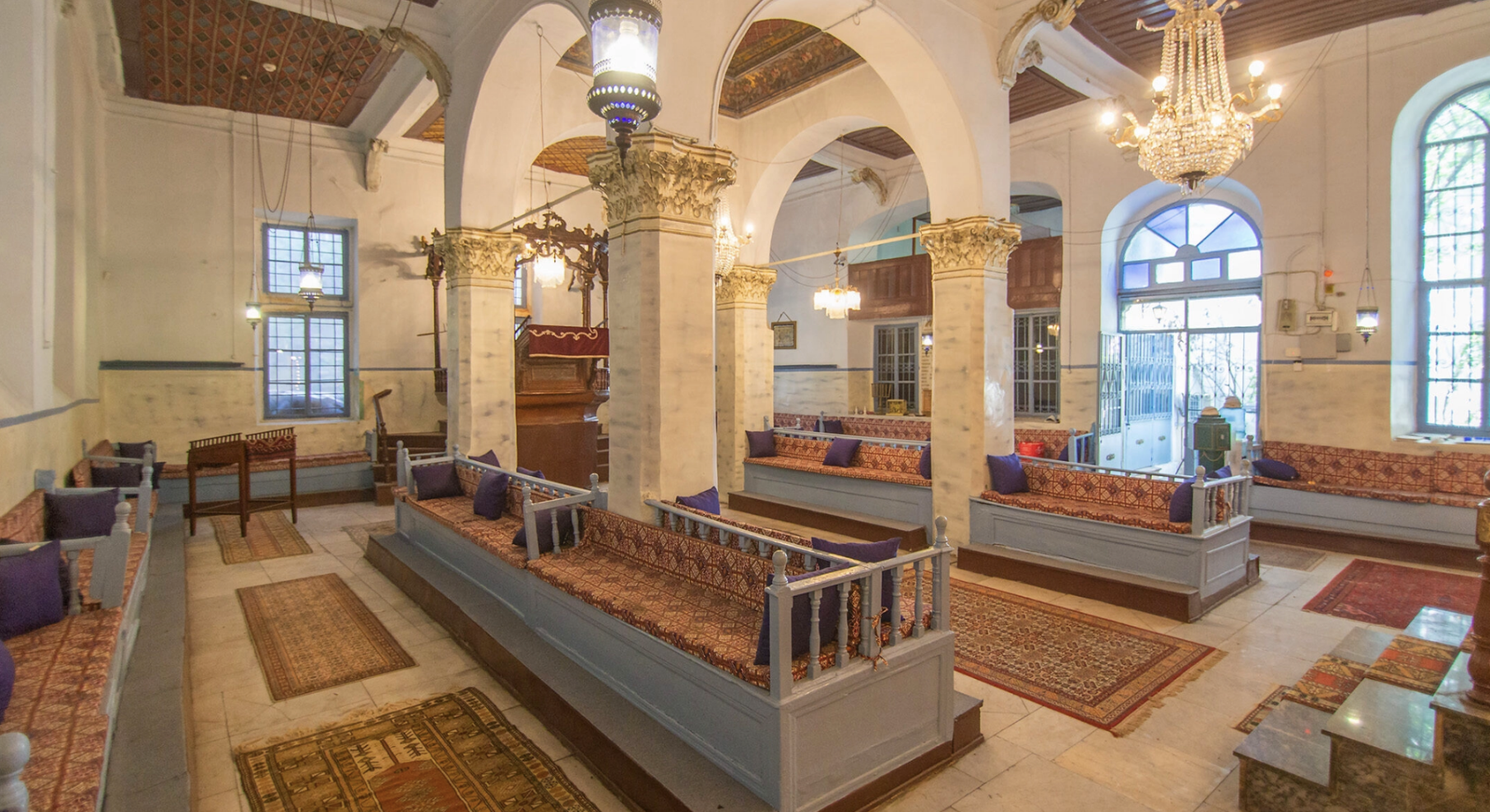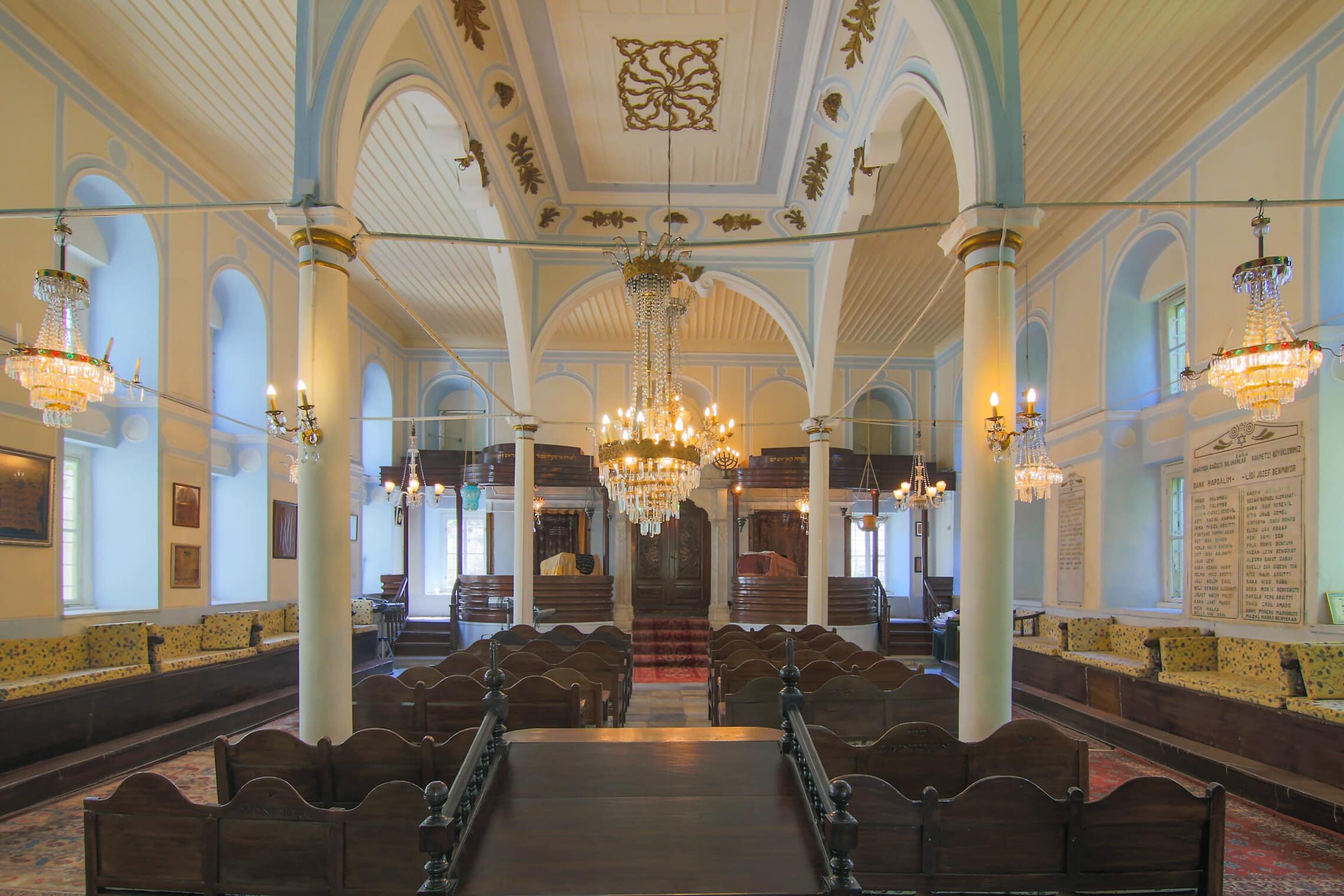
Synagogues
(Kemeraltı)
Algazi Synagogue
The Algazi Synagogue, believed to have been built by Ishak Algazi in 1724 based on the inscription at its entrance, holds a significant place in Izmir's history. However, there are claims suggesting that the synagogue may have existed as early as the 17th century and even had connections with Sabbatai Zvi in 1666.
The synagogue's basement floor served as a Midrash, functioning as a study hall, and a place where Asara Batlanim (ten old men) devotedly prayed for the welfare of the country and its people throughout the day. It was also used to store unused scriptures and religious objects, which were eventually buried according to Jewish traditions.
Ishak Ben Salomon Algazi, a member of the esteemed Algazi Family known for producing prominent rabbis, is associated with the Algazi Synagogue. Born in 1889, Ishak Algazi received his education at Yeshiva Bet Hillel and became a Hazan (cantor) at the Algazi Synagogue, following in the footsteps of his ancestors. He gained recognition as one of the most important composers of religious, secular, and classical Turkish music.
The Algazi Synagogue stands as a testament to the rich history and cultural contributions of the Algazi family, leaving a lasting impact on the Izmir Jewish community and the world of music.
Bet Hillel Synagogue
In the 19th century, Rabbi Hayim Palachi (1788-1869) and his son Rabbi Abraham Palachi (1809-1899) emerged as prominent theologians within the Izmir Jewish Community. Their influence extended beyond Izmir and the Ottoman Empire, attracting Jewish theologians from Europe and the Middle East to visit Izmir.
Rabbi Hayim Palachi authored a remarkable collection of 72 books during his lifetime, 26 of which were published. In recognition of his contributions, he was honored with the prestigious "Theologian in Charge of Justice" medal by Sultan Abdulmecid in 1861.
The building that once served as a yeshiva, where Rabbi Hayim Palachi and his sons received their education, was transformed into a place of worship by Rabbi Abraham Palachi in 1840.
Today, the Bet Hillel Synagogue and the tomb of Rabbi Hayim Palachi in Gurcesme Cemetery, along with the Mikveh (purification pool), hold special significance as sacred sites cherished by Palachi's students. This collection of sites has become known as the "Diamond Triangle."
The legacy of Rabbi Hayim Palachi and Rabbi Abraham Palachi continues to inspire reverence and admiration, leaving a lasting impact on the theological landscape of Izmir and beyond.
Bikur Holim Synagogue
Salomon de Ciaves, a Dutch immigrant of Portuguese origin, generously donated one of his spacious courtyard houses to the Jewish Community in Izmir in 1724. This donation served as the foundation for the establishment of a synagogue. In addition to providing the necessary religious books and sacred objects, Salomon de Ciaves also contributed neighboring houses and shops to generate income for the institution.
Over time, the synagogue came to be known as "Bikur Holim," which translates to "visiting the sick." This name may have originated from the period when the basement of the synagogue was used as a hospital during outbreaks of plagues or cholera, which were common in the city.
There are indications that the same basement may have also served as the Jewish Community's prison at some point. Sadly, the synagogue was destroyed by fire in 1772 but was reconstructed in 1800 by Manuel de Ciaves, a member of the same family.
Today, the synagogue stands as one of the most remarkable places of worship in Izmir. Its main prayer hall features a central plan design, a magnificent Tevah (prayer reading platform), and a beautifully adorned ceiling adorned with floral and fruit patterns. The columns are intricately painted in shades of green and yellow.
Etz Hayim Synagogue
The Etz Hayim Synagogue, a resilient structure that has withstood multiple fires and earthquakes, endured significant damage in the fire of 1841. However, it was meticulously restored by Daniel de Sidi in 1851.
In the early twentieth century, the layout of the synagogue underwent a transformation inspired by European synagogue architecture. The Tevah, originally positioned at the center, was relocated to the sides of the Ehal (Torah cabinet).
Historical records indicate an intriguing aspect of the synagogue's past. A document attributed to Salomon Ben Ezra, who passed away in 1688, mentions that Muslim Turks performed prayers within the premises of Izmir's sole surviving synagogue. It is believed that this occurred during the Turkish conquest of Izmir, when there was a lack of mosques in the city.
Forasteros Synagogue
Situated in the bustling Kemeraltı Bazaar and the old Jewish quarter of Izmir, this synagogue held two significant names.
Referred to as "Orahim" in Hebrew and "Foresteros" in Ladino, meaning "foreigners" or "guests" in both languages, it welcomed and accommodated new Jewish immigrants who joined the local Jewish community.
Constructed in the 17th century, the synagogue served as a vital hub until it was tragically destroyed by a fire. While its original function as a place of worship ceased, the synagogue's courtyard took on a new role as a kosher poultry slaughterhouse, where atonement offerings were made in preparation for the sacred day of Yom Kippur.
Hevra (Talmud Torah) Synagogue
The Hevra Synagogue, also known as the "Talmud Torah", has a rich history dating back to the period of Rabbi Joseph Escapa in the seventeenth century. Over the years, this synagogue has experienced multiple fires and subsequent reconstructions.
Following the fire in 1838, the building was reconstructed by Chelebi and Menahem Hacez brothers. However, it faced another devastating fire in 1841, leaving it in ruins for many years.
The Hevra Synagogue, designed with a central plan, exemplifies the typical architecture of Izmir synagogues. It features a Tevah (prayer reading platform), a triple Ehal (Torah cabinet) arrangement, and a Midrash (study hall). In its heyday, the synagogue housed a substantial collection of Sefer Torah (Torah scrolls), adding to its esteemed reputation.
Unfortunately, in 1999, the roof of the Hevra Synagogue collapsed. Although rescue efforts were completed in 2020, the restoration work for the synagogue is currently underway, aiming to restore this significant historical site to its former glory.
Portugal Synagogue
The Portugal Synagogue stands out among the synagogues in Izmir as the only one that bears the name of its founders, indicating their Portuguese origins. It is one of the six synagogues that existed during the tenure of Chief Rabbi Joseph Escapa in the 1620s, and it held the distinction of being the largest synagogue of its time in Izmir.
Throughout its history, the Portugal Synagogue has been witness to significant events, particularly during the 19th century when it became a focal point of Sabbatai Zvi's "messiah movement." Initially, the synagogue opposed Sabbatai Zvi, but as his movement gained momentum, the doors were closed to him. However, years later, Sabbatai and his followers stormed the synagogue, driving out the opposing rabbis and declaring the day as a liberation.
This incident marked a turning point as Sabbatai Zvi, who had proclaimed himself "the Messiah of the Jews," garnered new support and the Portugal Synagogue became the hub of the Sabbataist movement.
Sadly, the Portugal Synagogue suffered a devastating fire in 1976. However, in 2018, it underwent restoration and was revived as a center for social activities, preserving its historical significance for future generations.
Shalom Synagogue
Shalom Synagogue holds great historical significance as the synagogue where Chief Rabbi Joseph Escapa, who played a crucial role in organizing and leading the Jewish Community from 1620 onwards, served as a leader.
Rabbi Escapa was instrumental in providing religious education to Sabbatai Zvi in his youth. However, when Zvi proclaimed himself the "Messiah," Escapa took the lead in expelling him from Izmir.
Remarkably, Shalom Synagogue remained unharmed during the devastating fire of 1841. It stands as one of the most authentic synagogues in Izmir, characterized by its intricately engraved ceiling, floral cushioned sofas along the walls, and an interior reminiscent of a typical Anatolian house. Although originally designed with a central plan, the Tevah (prayer reading platform) was relocated in front of the wall opposite the Ehal (Torah ark) in 1939.
Shalom Synagogue continues to be a cherished symbol of the Jewish community's heritage in Izmir, preserving its historical and architectural significance.
Sinyora Synagogue
The synagogue endured several fires during the 17th century, and ultimately met its destruction in the devastating fire of 1841. However, it was reconstructed through the generous contributions of Moiz Bengiat Yerushalmi.
The architectural layout of the synagogue indicates a notable transformation from a central plan to a dual Tevah (prayer reading platform) design. The Ehal, adorned with Torah verses on its doors, showcases the distinct triple composition unique to Izmir synagogues.
Traditionally, it was believed that the synagogue was funded by Donna Gracia Nassi, a woman of Portuguese origin (1510-1569). However, recent research has unveiled that it was actually donated by a lady named Lea in 1664, who made the decision to immigrate from Izmir to the "holy lands."








